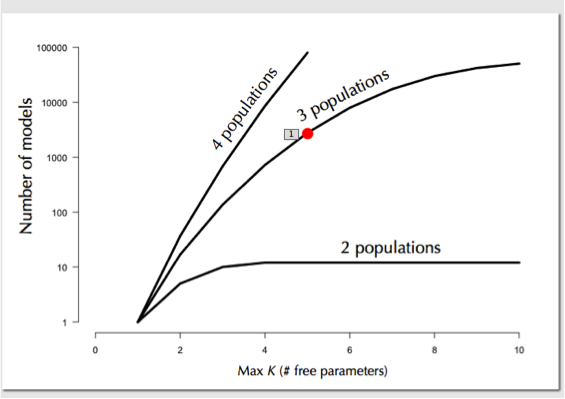HOW MODELS ARE BUILT IN PHRAPL
To run PHRAPL you need a set of models and it is important to understand how these models are built. Please take some time to read and understand how the free parameters are assigned in PHRAPL models.
Free parameters
PHRAPL will assign a certain number of free parameters (specified by the user or automatically) to population sizes, coalescent events, population growth, and migration rates.
The number of free parameters will constrain the possible number of histories that can be explored (model space search). For n sampled populations, the number of possible models will increase factorially.

Fig. Number of free parameters and possible models for 2, 3, and 4 populations.
Therefore, PHRAPL is more efficient with 2 or 3 population models. If you want to analyze models with more populations, it is required to filter the set models that will be examined. Otherwise, it would be a waste of computational resources.
Free parameters
Population sizes - special case
PHRAPL will always assign one parameter to population size, otherwise the populations do not exist. This parameter used for population size for the moment is not completely “free”, and should not be counted to generate a ‘migrationArray’ object.

Fig. An example of free parameter assignments to population size when K=0, K=1, and K=2. There are no coalescent or migration events.
Collapse (or coalescent) event
There are [(2n)-1] possible events of populations merging (coalescent events). Each coalescent event will require one parameter. If this value is 0, your system represents an island population model.

Fig. An example of free parameter assignments to coalescent events when K=0, K=1, and K=2. There are no migration events.
Population growth
Changes in population size before or after a coalescent event.
Migration
There are (N^2 - N) possible migration rates between populations.

Fig. An example of free parameter assignment to migration rates when K=0, K=1, and K=2. There are no coalescent events. Only one scenario for k=2 is shown.